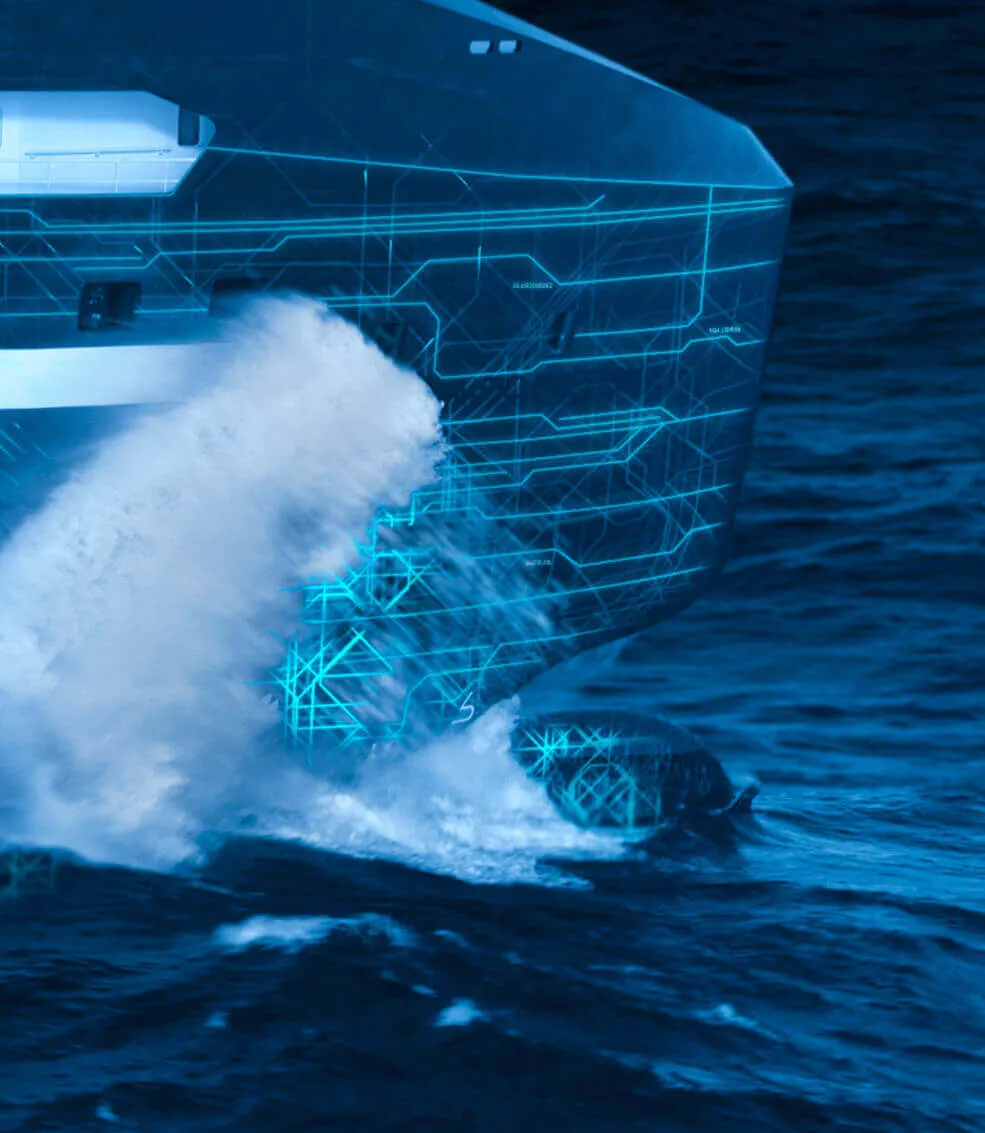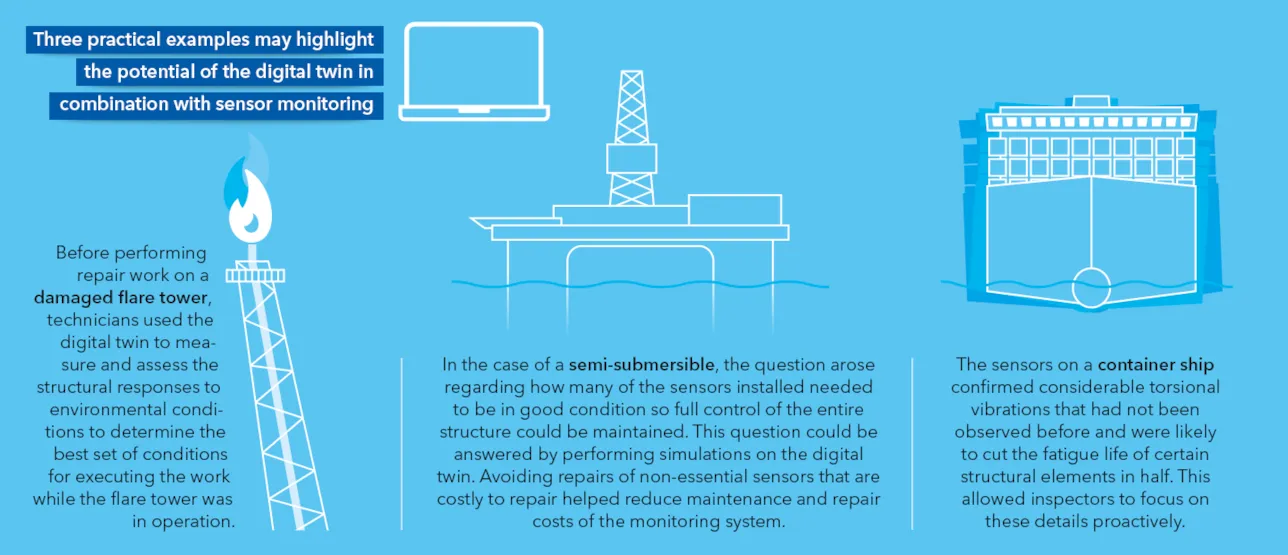Digital twins and sensor monitoring
DNV GL has developed a methodology for hull condition monitoring that incorporates the use of the ship’s digital twin, a virtual model prepared during the design stage. Combined with wave, position and sensor monitoring, it vastly enhances the value of predictive and preventive maintenance.
"Design models, which are also sometimes referred to as digital twins, die at birth. It is our ambition to bring these models back to life during the operational phase of an asset," says Dr Gaute Storhaug, Principal Specialist at DNV GL Maritime Advisory. In its Nerves of Steel Extraordinary Innovation Project, DNV GL - Maritime has been investigating new ways of calculating the wave-induced damage risk for ship hulls. Designers and yards invest significant amounts of time and money in preparing analytical models to document the design of ships and offshore structures and to perform simulations. The continued use of such a virtual model as a digital twin during operation is a great means to visualize all key components, perform analyses and calculations, and improve the understanding and control of the long-term effects of operation on the ship’s structural and functional components. This adds significant value to the asset.
In addition, a digital twin can be very useful for inspection and maintenance planning, while extending the ship's lifetime through preventive actions to avoid hull damages. The increased transparency and control that the digital twin provides can even result in a competitive advantage by improving predictability. This makes the vessel more attractive to cargo owners, banks, insurance companies, class societies, vetting companies, investors, buyers and other stakeholders.

Sensors create synergies in monitoring
"Using sensor technology to determine the response of a vessel or offshore structure to specific wave conditions, as well as to monitor structural and functional components, is common practice in the industry today," says Ørjan Fredriksen, Senior Engineer, Technical Advisory Structures, who was the project manager for the Nerves of Steel Extraordinary Innovation Project. "Sensors can capture physical effects such as deformation, vibration or temperature under real-life conditions that cannot always be easily described by numerical models," he adds. "But the number of sensors installed on board limits the number of data points available to monitoring. Considering the complexity of modern ships and the interdependencies between all their components, comprehensive instrumentation can provide crucial insights."
Combining the data provided by these sensors with the ship's digital twin makes sensor-based hull condition predictions much more meaningful and accurate. It does this by extending the range of structural details accessible to monitoring. This may include any element considered during the design that may be critical during operation. Examples of typical fatigue-critical details on ships are the stiffener end connections of frames and transverse bulkheads, stringer toes and heels, or terminations of hatch coamings.
A hybrid monitoring approach as described above can also be helpful in determining the best sensor positions to ensure cost-effective instrumentation. This concept has been applied successfully on assets of various types, including container ships, FPSOs, semi-submersibles, flare towers, pipelines, and fixed platforms.


A crucial aspect: sensor data quality
DNV GL is currently piloting the hull condition monitoring methodology, working together with several stakeholders in the maritime and oil and gas industries. The ambition is to enable owners to monitor their assets in real time, either through the innovative DNV GL Nerves of Steel user interface, which will be available on the DNV GL Veracity platform, or by using technology directly integrated in their own systems.
Sensors are offered by hundreds of suppliers, but one wide-spread problem is data quality. If the data output of a sensing element cannot be trusted, it is useless in any decision-making process.
"Verifiable data quality is a key requirement of authorities and across the industry," explains Lars Holterud Aarsnes, Nerves of Steel Project Manager. The DNV GL rules for alternative survey arrangements state that "any sensor data used shall be quality assured". To facilitate the implementation of this rule, DNV GL provides a quality assurance app for hull monitoring suppliers through its Veracity portal. The app's data quality dashboard applies sensor-specific rules to verify the plausibility of the statistical data collected so it can be useful to the owner.
The term sensor, for the purposes of this discussion, includes not only sensors in the narrow sense but also the output of transducers and indicators as well as numerical and hybrid sensing elements. The DNV GL hull monitoring rules associated with the HMON class notation basically cover any sensor type. They require automatic on-board processing and storing of statistical data, which can be uploaded by the supplier to the Veracity cloud automatically or manually after conversion to the compact Veracity format. The quality dashboard then reads the data and presents it on a web interface. Any data quality issue is evident promptly, and data quality improvements following maintenance by the supplier can be confirmed by the system.

Building trust in data
Once the ship-owning company can see that the data is trustworthy, they can use it for decision support using the results dashboard. The leading provider of hull monitoring solutions has been feeding data to this data quality dashboard for many ships and owners. In addition to this standard app for assessing the quality of statistical data, DNV GL has established a Data Management Competence Centre to support tailor-made solutions involving alternative sensor types, data formats or dashboards. The data quality and decision support dashboards can be merged into a single one, which is frequently done to enhance awareness of the hull condition and take appropriate proactive steps to ensure safety and reduce operational risks and costs.
This system can be used by all industries using statistical data for equipment monitoring, including oil and gas, and wind energy, and for purposes far beyond structural monitoring, such as fuel and emission studies, navigation, or tail shaft monitoring. Structural monitoring is quite common on FPSOs and gas carriers today. On cruise ships, yachts and passenger ships, where excessive vibration can lead to passenger complaints and reputational damage, it can play an important role in comfort monitoring.
"Amazingly," says Dr Storhaug, "as little as 1% of the data available on board has been used for shore-side decision support on average! We encourage owners to make better use of this valuable resource. In many cases, the benefits become more numerous and apparent once the data is available." "Being able to supply monitoring data while demonstrating high data quality builds trust among all key stakeholders, from charterers and operators to insurance companies, and can ultimately be a significant competitive advantage," Aarsnes stresses.
Contact us

